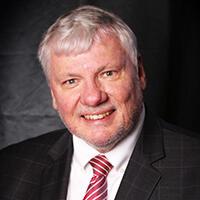
Forty-nine states. One district. Fifty countries.
Thirteen years after its launch, ·¬ÇÑÊÓƵ is an ever-growing leader in online education. But when Ken Jandes first joined the college, it was just a fledgling institution, trying to spread its wings.

Ken and the college have come a long way since then. He recently celebrated his 10-year anniversary with ACE so we sat down to discuss their joint evolution, how students are benefiting from the college’s strides and what he’s loved most about growing up with the college.
·¬ÇÑÊÓƵ: How have you seen the college evolve since you first started back in the early 2000s?
Ken Jandes (KJ): Just from a geographic standpoint – where now we’re in 49 states and 50 different countries – back then we were only operating in two regions: in Chicago and the northern suburbs.
When I joined, we had just graduated the first 24 students in the educational leadership program, and every one of those graduates got administrative positions in the Chicago Public School systems, and that word spread like wildfire throughout CPS. In July of 2007, we had 250 students enroll in that same program. Then, in August, just six weeks later, we had another 250 students enroll. So we went from 24 students in the EL program to 500 students in the EL program in just two and a half months, three months of time.
ACE: That’s close to a 2,000 percent increase.
KJ: Needless to say, we were not ready for an increase of that magnitude. Plus, we were using a blended model of programming, and we had very limited Internet access. We didn’t even have a viable website at the time, so this blended model involved those 500 students traveling to 30 or so different cohorts in and around the city of Chicago.
They each had to find a practicing principal, they had to go to the school where the principal was located, they had to go through probably 25-30 different internship activities and write them up. So you can imagine with 30 different activities with 500 different students, we had 15,000 activities that were coming in over the 18 months. So every week after I finished coding all of the internship activities from the students, I would FedEX them weekly to Dr. Oceana Wright [the former interim assistant chair] in Dallas and she would file them down there.
That we got through it is an absolutely amazing feat. And that was only eleven years ago, so to see where we are today – to have a global presence and reach a place where we’ve optimized the online experience – is a testament to our dedication to what we’re building here.
ACE: And you’ve been a crucial part of that building process. How did you go from hustling around Chicago to overseeing the Office of Academic Excellence (OAE)?
KJ: Well, after contracting me as an internship director, they brought me on as a professor and then ultimately as chair of the educational leadership department. About a year after that, sometime in 2009, they made me the associate academic dean, and that was my title until the first of this year, when they decided to do away with deans altogether. At that point, they promoted me to my current position.
ACE: So, if you had to explain it to students, what exactly does OAE do?
KJ: OAE has more than 20 areas of responsibility. We maintain the writing center and the digital tool center, and we just recently built out the career services center. Most of our 4,700 graduate students have jobs, but we’re having our first 15 or 16 undergraduate students [as part of our ], so they’re going to use the center more than anyone. It’ll be there to help with resume and cover letter writing, taking advantage of social media in the job search, and finding professional associations to join.
[Other] responsibilities [of OAE] include working with students needing disability support, overseeing the committees for plagiarism and disciplinary issues which may arise in courses, creating outreach to faculty serving on dissertation committees, reviewing dissertation courses to confirm students are progressing, and ensuring final dissertations are in APA compliance. We’re like the fire department for the college – we put out the fires.
ACE: Ha! So what’s it like being a firefighter?
KJ: For me, no day looks the same. [It’s all about] being flexible and willing to take on many responsibilities associated with different departments throughout the college.
ACE: What makes the college different than other schools where you’ve worked?
KJ: The biggest advantage we have is we can turn on a dime. If we need to make changes, if students bring issues to us or faculty brings issues to us, we can put those changes together in a matter of days or, at most, a couple of weeks. Other colleges and universities have to go through a faculty summit or top-level administration to make changes, and sometimes that process takes six months to a year.
And we’re that few colleges and universities can match our price. We’re accessible.
And then there’s our leadership. Shawntel Landry [the president at ·¬ÇÑÊÓƵ] is the best leader I’ve seen in 52 years in education. In all the other colleges and universities that I’ve taught in as an adjunct, I never once got a letter from the president thanking us for what we do. That is Shawntel, and that is the kind of leadership that makes a huge difference in allowing people to work for her and bend over backward to make this college a success.

